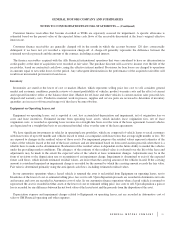General Motors 2014 Annual Report Download - page 73
Download and view the complete annual report
Please find page 73 of the 2014 General Motors annual report below. You can navigate through the pages in the report by either clicking on the pages listed below, or by using the keyword search tool below to find specific information within the annual report.
GENERAL MOTORS COMPANY AND SUBSIDIARIES
NOTES TO CONSOLIDATED FINANCIAL STATEMENTS — (Continued)
Advertising and Promotion Expenditures
Advertising and promotion expenditures, which are expensed as incurred in Automotive selling, general and administrative
expense, were $5.2 billion, $5.5 billion and $5.4 billion in the years ended December 31, 2014, 2013 and 2012.
Research and Development Expenditures
Research and development expenditures, which are expensed as incurred in Automotive cost of sales, were $7.4 billion, $7.2 billion
and $7.4 billion in the years ended December, 31 2014, 2013 and 2012.
Cash Equivalents
Cash equivalents are defined as short-term, highly-liquid investments with original maturities of 90 days or less.
Allowance for Doubtful Accounts
We record an allowance for doubtful accounts based on our best estimate of recoverability of receivables. Charges related to the
allowance for doubtful accounts are recorded in Automotive selling, general and administrative expense. The following table summarizes
activity in our allowance for doubtful accounts and notes receivable related to our automotive operations (dollars in millions):
Years Ended December 31,
2014 2013 2012
Balance at beginning of period ........................................................... $ 344 $ 311 $ 331
Amounts charged (credited) to costs and expenses ........................................... 50 61 (10)
Deductions .......................................................................... (8) (24) (46)
Effect of foreign currency and other ....................................................... (46) (4) 36
Balance at end of period ................................................................ $ 340 $ 344 $ 311
Fair Value Measurements
A three-level valuation hierarchy, based upon observable and unobservable inputs, is used for fair value measurements. Observable
inputs reflect market data obtained from independent sources, while unobservable inputs reflect market assumptions based on the best
evidence available. These two types of inputs create the following fair value hierarchy:
• Level 1 — Quoted prices for identical instruments in active markets;
• Level 2 — Quoted prices for similar instruments in active markets, quoted prices for identical or similar instruments in
markets that are not active and model-derived valuations whose significant inputs are observable; and
• Level 3 — Instruments whose significant inputs are unobservable.
Financial instruments are transferred in and/or out of Level 1, 2 or 3 at the beginning of the accounting period in which there is a
change in the valuation inputs.
Marketable Securities
We classify marketable securities as available-for-sale or trading. Various factors, including turnover of holdings and investment
guidelines, are considered in determining the classification of securities. Available-for-sale securities are recorded at fair value with
73
























